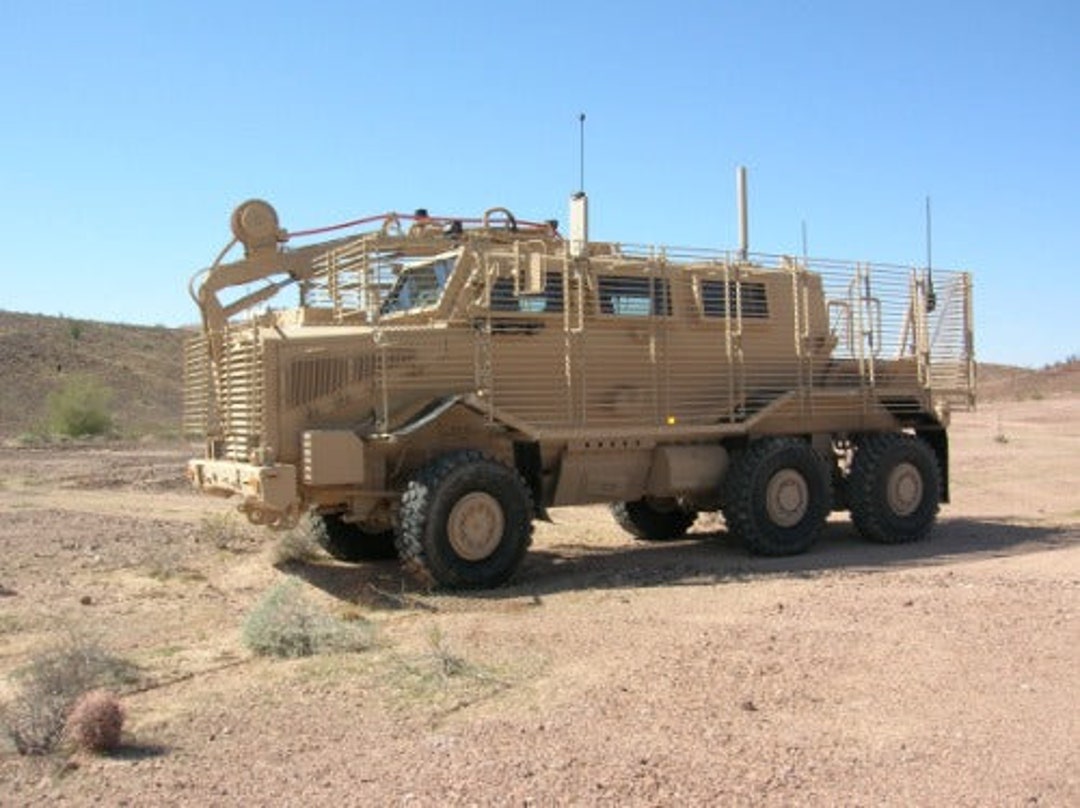Buffalo Military Vehicle - The Buffalo vehicle was designed based on the successful South African Casspir mine-protected vehicle.[2] While the Casspir is a four wheeled vehicle, the Buffalo has six wheels. Buffalo is also fitted with a large articulated arm, used for ordnance disposal. Both vehicles incorporate a "V" shaped monohull chassis that directs the force of the blast away from the occupants.[3]
Buffalo is also now equipped with BAE Systems' LROD cage armor for additional protection against RPG-7 anti-tank rounds.[4] Glass armor is sufficient at 6 inches thickness. Run-flat tires are present in all tires. The Buffalo combines ballistic and blast protection with infrared technology to detect the presence of dangerous ordnance and a robotic arm to disable the explosive ordnance. Personnel operate the Buffalo’s 30-foot robotic arm and claw from within the armoured hull via a mounted camera and sensory equipment, to safely dispose of mines and IEDs.
Buffalo Military Vehicle

Related: I Don’t Work Here, Does Not Work Here, Part 46 I Don’t Work Here, Does Not Work Here, Part 45 I Don’t Work Here, Does Not Work Here, Part 44 I Don’t Work Here, Does Not Work Here, Part 43 I Don’t Work Here, Does Not Work Here, Part 42

Notable Appearances In Media
The Buffalo appeared as the vehicle aspect of the Decepticon Bonecrusher in the movie Transformers (2007), and in the sequel, Transformers: Revenge of the Fallen. Production designer Jeff Mann stated, "We found this image of a mine-sweeping vehicle that had a huge arm with what appeared to be a fork on the end. So we called the people who owned it, hoping there was a chance we could rent it or buy it, but when we got the data, it turned out the fork was only 14 inches (360 mm) wide—they had totally cheated the whole thing in Photoshop.... We had to make an appliance to fit over the existing arm, that wouldn’t bounce around too much because it was about 10 feet (3.0 m) wide."[16]
In December 1995 RR & VO LLC, Rockville, Maryland, was awarded a $14,340,847 time charter contract for the 17-month charter of roll-on, roll-off/container ship MV Buffalo Soldier. This contract had options which, if exercised, would bring the cumulative value of this contract to $40,436,542. MV Buffalo Soldier carried prepositioned equipment for the U.S. Air Force in the Indian Ocean and the Mediterranean Sea. The US Navy's Military Sealift Command Central Technical Activity is the contracting activity.
Air Force Tech. Sgt. John A. Chapman was killed in action in Afghanistan in 2002 and was posthumously awarded the Air Force Cross for his heroism. On 08 April 2005 T-AK-323 Merlin was named for Chapman at a pierside ceremony in Southport, NC. More than 300 people, including Chapman's friends, family and fellow combat controllers, attended the ceremony at Military Ocean Terminal, Sunny Point in Southport, NC. This was the first prepositioning ship to be named for an Air Force Cross recipient. The 670-foot container/roll-on/roll-off ship is crewed by 19 U.S. commercial mariners and is owned by Sealift Inc. The ship is under contract to the U.S. Navy's Military Sealift Command. T-AK-323 TSgt. John A. Chapman, formerly T-AK-323 Merlin, rejoined Squadron One in June 2005. MV Chapman strategically prepositions Air Force ammunition in the Mediterranean Sea and eastern Atlantic Ocean.

In December 1995 Merlin Shipbuilding, Bethesda, Maryland, was awarded a $14,469,535 timecharter contract for the 17-month charter of roll-on, roll-off/container ship MV American Merlin [T-AK 9302]. This contract had options which, if exercised, would bring the cumulative value of this contract to $40,306,605. MV American Merlin carried prepositioned equipment for the U.S. Air Force in the Indian Ocean and the Mediterranean. The U.S. Navy's Military Sealift Command Central Technical Activity was the contracting activity. As of March 1997 Maritime Prepositioning Squadron ONE, forward deployed in the Mediterranean, was composed of five ships: Three Waterman Class - SS PFC Eugene A. Obregon which was the flagship, SS SGT Matej Kocak and SS MAJ Stephen W. Pless; one Amsea Class, MV John P. Bobo which served as an alternate flagship; and one Air Force ship, MV American Merlin.

Ak Buffalo Soldier
A very sweet “little old lady” customer comes in on a particularly slow day. I show her around the store and chat about our products and life in general for about half an hour, the whole time thinking I am putting in the customer relationship time and laying the groundwork for her future business. Then, she turns to me and says:
In 2004, the United States had a limited number of Buffaloes in service, with an order for 15 more, at a cost of $10 million.[5] On June 6, 2008 Force Protection, Inc delivered its 200th Buffalo to the U.S. Military.[6]
AK 9301 Buffalo Soldier was one of three ships chartered to support the US Air Force's ammunition prepositioning mission. Buffalo Soldier is a roll-on/roll-off self-sustaining container ship built in 1978. She is 670 feet long, 87 feet wide and has a deadweight tonnage of 26,438 long tons. The ship has 143,000 square feet of cargo carrying capacity, or room for 1,063 20-foot containers. Its 120-long-ton capacity roll-on/roll-off ramp enables most any vehicle to be driven aboard. It can sail at a speed of 16 knots. Buffalo Soldier was prepositioned in Diego Garcia. The ship is named in honor of African-Americans who served in the Union Army during the US Civil War.
buffalo mine clearing vehicle, buffalo mine protected vehicle, buffalo route clearance vehicle, buffalo clearance vehicle, military buffalo truck, buffalo armored vehicle, us army buffalo vehicle, route clearance vehicles

0 Comments